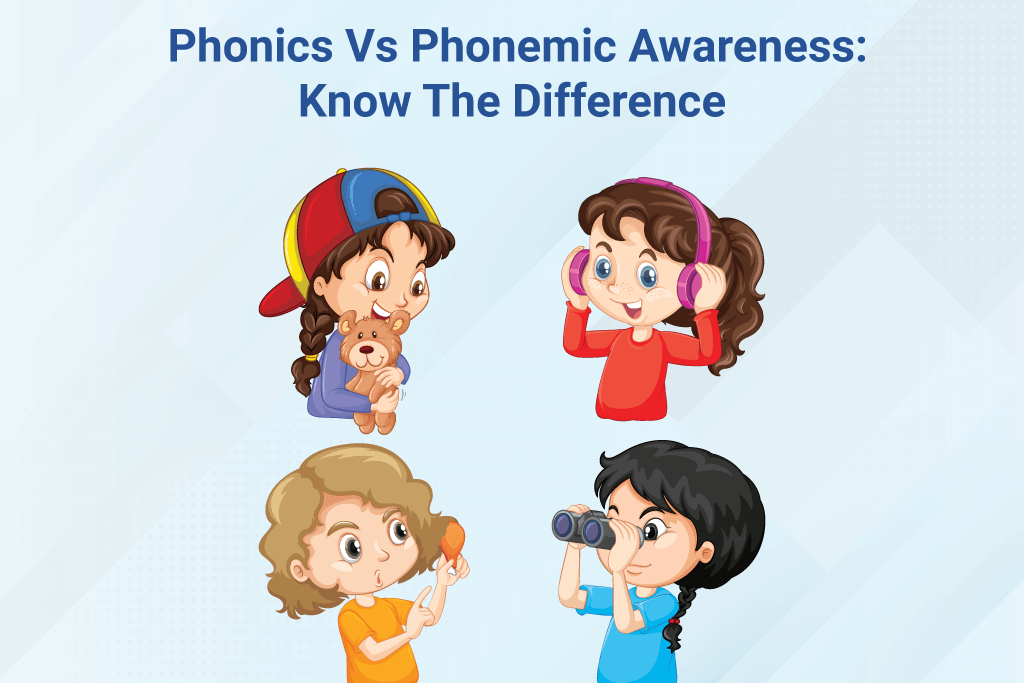Phonics Vs Phonemic Awareness: Know The Difference
While teaching students in their formative years, you might come across two different concepts. These concepts are phonics and phonemic awareness. Both of these concepts are very crucial in promoting early reading development among students. However, there is a difference between the focus and application of phonics vs phonemic awareness.
If you want to enhance your literacy instruction and make it more effective, it is essential to understand the difference between these two concepts. Understanding the difference will allow you to strategize your lessons in a way that students can make the most of it.
Eventually, how much progress a student gains in his reading and grammar skills depends on how well you guide them. So, let us explore the difference between phonics and phonemic awareness definition.
Discover the difference between phonics and phonemic awareness today!
A] What Is Phonological Awareness?
Phonological awareness is the ability of a student to recognize and manipulate the sounds of spoken language. It includes the development of skills that help a child identify individual sounds, also called phonemes. Students can only decode large or heavy words when they have an understanding of syllables and rhymes.
Phonological awareness forms the basis of reading and spelling for the child. It lays the foundation for understanding the relationship between letters and sounds. Teaching phonological awareness to a child includes segmenting, blending, and manipulating sounds in words.
For example, segmentation involves breaking a word into its individual phonemes (e.g., “cat” into /k/ /a/ /t/). Similarly, blending involves combining individual phonemes to form a word (/k/ /a/ /t/ into “cat”). Manipulating sounds is also a part of phonological awareness. It can include tasks like substituting one phoneme for another to create a new word (e.g., changing the /b/ in “bat” to /r/ to create “rat”).
B] What Is Phonemic Awareness?
Phonemic awareness is the specific ability to focus on and manipulate individual phonemes. This concept is somewhat different from phonological awareness. Phonological awareness involves decoding syllables and rhymes. However, phonemic awareness focuses only on single phonemes.
For example, phonemic awareness involves identifying the initial, middle, or final phoneme in a word. For example, you can consider a student aware of phonemics when he can easily identify all phonemes in the word ‘dog.’ He must be able to segment a word into its individual phonemes (e.g., breaking “dog” into /d/ /o/ /g/) and also blend it.
Phonemic awareness is an essential skill in a student that helps in developing phonics proficiency. With this awareness, students can easily decode words while reading and spelling.
C] Phonological Awareness Vs Phonemic Awareness
Let us look at the differences between phonological awareness and phonemic awareness.
1. Scope
Phonological awareness is a broad term. The skills related to the understanding and manipulation of sounds in language fall under the phonological umbrella. Phonics learning for kindergarten involves recognizing syllables, rhyming, and identifying words in sentences.
Phonemic awareness is just a subset of phonological awareness. It aims to teach students how to isolate, manipulate, and identify individual phonemes in a word.
2. Relationship To Reading
Phonological awareness lays the foundation for reading. It helps children develop an awareness of the sounds in language. It is a precursor to phonics instruction that focuses on helping students connect sounds to letters.
Phonemic awareness is the key to bringing reading success to a child. It helps children understand the alphabetic principle. When they learn phonics, they get the idea that letters represent sounds in written language. Once children become proficient in phonemic awareness, they can easily decode words accurately while reading.
3. Involvement Of Written Language
The main aim of developing phonological awareness in a child is to deal with the sounds of spoken language. It does not necessarily involve written text.
Phonemic awareness also focuses on spoken language. However, it is closely connected to written language. With phonemic awareness, children understand the relationship between sounds and letters.
4. Application
Skills such as rhyming and segmenting words into syllables are essential for developing phonemic awareness. Activities like identifying words with the same initial sound or clapping out syllables in a word are examples of phonological awareness examples.
Segmenting, blending, and manipulating individual phonemes, are a part of phonemic awareness. Phonemic awareness examples include segmenting the word “cat” into /k/ /a/ /t/ or blending the sounds /sh/ /i/ /p/ into “ship.” The ability to easily connect these phonemes demonstrates phonemic awareness in a child.
D] Importance In Literary Development
Both phonological and phonemic awareness play a critical role in the development of literacy skills. They serve as foundational building blocks for developing reading and writing proficiency in a child.
Under the phonological umbrella, phonological awareness skills such as rhyming, syllable segmentation, etc., provide children with a deep understanding of the sounds. This understanding helps them know what makes up language.
Phonemic awareness helps in bringing reading success to children. When children can recognize sounds and words, they can decode words and spelling accurately. Phonemic awareness helps in bringing reading fluency to children. A child with good phonemic awareness can also decode big and difficult words easily.
Discover the difference between phonics and phonemic awareness today!
Conclusion
Phonological and phonemic awareness are integral components of early literacy development. These two concepts lay the groundwork for proficient reading and writing among students. However, educators must understand the difference between phonics and phonemics so that they can deliver the best instructions to students.
Phonological awareness mainly includes a range of sound-related skills. On the other hand, phonemic awareness specifically focuses on individual phonemes. Both of these skills are crucial for understanding the alphabetic principle and mastering phonics.
A child who can master these skills becomes an excellent reader and proficient in grammar. These skills help in bringing confidence in students and help in bringing academic success. To explore further and enhance your child’s phonics literacy you can enroll them in phonics classes in Mumbai today!

Hema Dave
Stemming from the aspiration to nurture and inspire young minds, Hema started her professional journey into education 20+ years ago. She founded 'Phonic Smart' as a trained educationist, an institute committed to equipping children with phonics skills and helping parents and teachers implement them effectively. Her diverse skill sets, encompassing teaching, teacher training, and coaching allow her to contribute valuable insights to the education industry.


